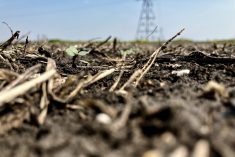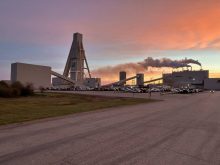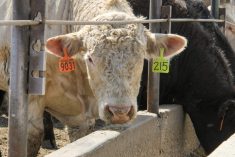CNS Canada — A rise in prices for soybeans and other crops could make fertilizer more expensive in the coming months, according to a major player in the industry.
In the May market report from the Mosaic Co., the company credited the rally in agricultural commodity prices, the strengthening of key currencies and various Indian subsidies and Brazilian political dramas as helping raise the prospects for a rebound in nitrogen, phosphorous and potash values.
“We’ve seen a big rally in soybean prices,” explained Michael Rahm, vice-president of market and strategic analysis with Mosaic in Minnesota, “and we’ve seen decent increases in many of the ag commodity prices that we think underpin good demand prospects.”
Read Also

China to buy 12 million metric tons of soybeans this season, Bessent says
U.S. Treasury Secretary Scott Bessent said on Thursday that China has agreed to buy 12 million metric tons of American soybeans during the current season through January and has committed to buying 25 million tons annually for the next three years as part of a larger trade agreement with Beijing.
Fertilizer usage north of the border is keeping steady according to two prominent producers on the Prairies.
“Fertilizer isn’t cheap, but prices have been flat through most of the winter,” said Doug Chorney, a former president of Keystone Agricultural Producers who farms north of Winnipeg. “I bought most of my fertilizer in the winter and prices have not changed dramatically since then.”
Another farmer says despite excessively dry conditions in Alberta, he hasn’t seen anyone cutting back on fertilizer usage this spring.
“I think it’s pretty well the same; people have bought stuff earlier and they’re using it, hoping that they can get enough rain to use it up,” said Lynn Jacobson, the president of the Alberta Federation of Agriculture who farms southeast of Calgary.
Looking at the second half of the year, Rahm said other factors could also boost demand and strengthen the market. Chinese potash contracts, uncertainty in Brazil and India’s apparent plan to purchase phosphate later than normal are some of the main ones.
As well, the effects of a potential La Nina weather system on growing areas must also be considered.
“If La Nina comes about sooner than expected and you get a bit of a growing problem with the North American growing season that could provide additional fireworks in the ag commodity complex and could be the biggest swing factor,” he explained.
Recovering oil prices and appreciations in major currencies, most especially the Russian ruble, are also supportive for the fertilizer market.
“That rebound in (Russian) currency, coupled with domestic inflation prices, is beginning to pinch or squeeze margins,” said Rahm.
But he stresses the ag commodity complex is what they’ll be watching most carefully throughout the summer.
“The Northern Hemisphere growing season will be key to watch, as will weather in June, July and August.”
— Dave Sims writes for Commodity News Service Canada, a Winnipeg company specializing in grain and commodity market reporting. Follow CNS Canada at @CNSCanada on Twitter.












